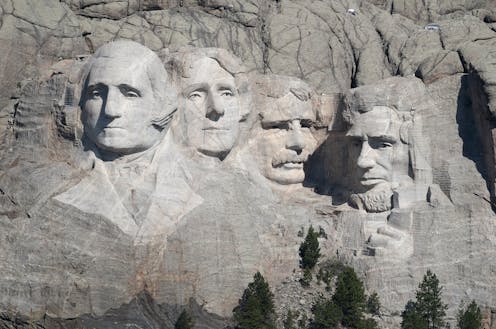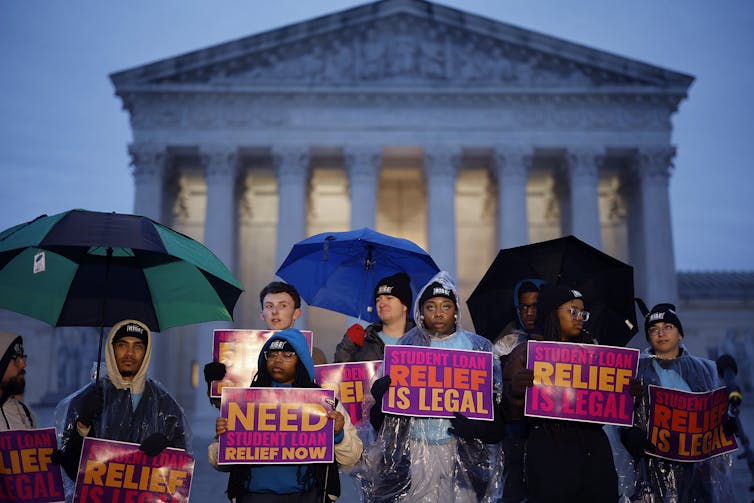What are the limits of presidential power to forgive student loans? A constitutional law expert answ
The Supreme Court is considering the legality of the Biden administration’s student loan forgiveness plan and whether the administration had the power to offer debt forgiveness in the first place.

There’s about US$430 billion on the line for 40 million people in the Supreme Court’s upcoming decisions on student debt forgiveness.
But for President Joe Biden, the extent of the executive branch’s power is also at stake.
In August 2022, Biden announced that the U.S. Department of Education would cancel federal student loan debt for borrowers making less than $125,000 a year. The plan was designed to blunt the continuing financial hardships student loan borrowers suffered during the COVID-19 pandemic.
By executive action, the president determined the secretary of education would cancel $20,000 of debt for borrowers who were Pell Grant recipients and $10,000 for others through the 2003 Higher Education Relief Opportunities for Students Act, or HEROES Act. It empowers the federal government to change student loan programs in response to national emergencies.

But the state of Nebraska and six others challenged the program in federal court, claiming in part that it’s an overreach that violates the separation of powers. A second lawsuit, this one brought by two students, argued that the secretary of education did not have the authority to establish the plan and asked the federal court to set it aside. Both cases are now before the Supreme Court.
The Biden administration argues that none of the plaintiffs have suffered actual injuries and are not the proper parties to sue. But if the Supreme Court disagrees, it will then decide whether the administration followed the correct procedures in adopting the plan and whether executive power covers an expansive debt cancellation plan. The answers will rest on fundamental principles regarding how the Constitution divides power between Congress and the president.
The Conversation asked Derek W. Black, a legal scholar who specializes in constitutional law and education, to describe executive power and its role in the legal battles over student debt forgiveness.
1. What authority does the Constitution give the president and his administration?
The Constitution divides power among the three branches of government to ensure none of them has too much. There is the legislative branch, made up of both houses of Congress; the executive branch, composed of the president, vice president, the president’s cabinet and federal agencies, including the secretary of education and the Department of Education; and the judicial branch, which includes federal district courts, courts of appeal and the Supreme Court.
Congress enacts legislation, sets taxes, authorizes public expenditures and establishes substantive policies and rules.
The executive administers and enforces that legislation. In many instances, legislation also authorizes agencies to make certain lower-level policy decisions – either through regulations or executive action.
And the judicial branch determines whether the legislature or the executive breached constitutional or statutory rules in carrying out their duties, including whether they violated anyone’s rights or exceeded the scope of their authority.
2. Can the president determine how government spends money?
Only Congress can appropriate money. Congress passes appropriations bills each year that authorize a specific level of funding for federal projects and agencies. The Department of Education, for instance, receives a specific dollar amount every year to spend on all of its programs.
There’s no freewheeling authority for the executive branch to spend however much money it wants. There’s no provision in the Constitution for that. The president has no power to tax anyone, nor any power to spend money, except for the taxes and spending that Congress has authorized for the president and his various agencies.
With the student loan forgiveness program, the president wants the secretary of education to waive students’ debt and assume responsibility for paying off loans with money that Congress has not yet appropriated.
3. Does the executive branch have the authority to forgive debt that students owe?
Yes, but there are caveats. The president and other members of the executive branch, such as the secretary of education, can forgive debts only when Congress authorizes it. One 2007 law established the Public Service Loan Forgiveness program, which permits the secretary of education to forgive student loans after debt holders work in public service jobs for 10 years. The HEROES Act gives the secretary of education the power to waive or modify student loans during times of emergency.
The current cases do not call into question the public service program. Instead, they challenge the emergency program.

4. If the executive branch has the authority to forgive student debt, why are the plaintiffs suing?
It is really about the scope and details of the secretary of education’s power, rather than a general question of whether he has power.
The problem is that Congress, in the emergency debt relief law, explicitly gives the secretary power to waive or modify student loans during times of emergency, but it does not specify a cap for the loan amounts the secretary may waive or modify. Nor does Congress set aside a chunk of money necessary to cover all the potential loans the secretary might modify or waive.
The question is whether Congress can give the executive branch what amounts to a blank check to spend on student loan forgiveness.
The administration argues that because Congress didn’t place any limit on the secretary of education’s waiver and adjustment power, the secretary can adjust or cancel as many loans as he wants, and Congress has implicitly agreed to pick up the tab.
The plaintiffs are saying that Congress didn’t intend to give the executive such wide power to adjust and waive student loans, because that would mean practically unlimited spending power for the executive branch.
5. How has the Court’s approach to executive power changed over time?
Executive power was relatively limited until the 1940s. The Supreme Court rejected attempts by Congress to delegate power to the executive branch.
But in an increasingly complex world where good policy depends on expert analysis and evolving facts, Congress is ill-positioned to deal with some issues. Congress could know, for instance, that air pollution is bad, but determining exactly how much particulate in the air is too much – or, for that matter, which particulate is harmful – is beyond Congress’ capabilities.
So, Congress began delegating important policy questions to the executive branch. Over the past century, the Supreme Court has largely permitted that delegation.
But the current Supreme Court is concerned about increasingly expansive executive power that upsets the balance of power between Congress and the president. This Supreme Court often requires very specific statutory support when the executive branch takes sweeping action on issues of major significance – what legal scholars call the major questions doctrine. The Supreme Court will not, as Justice Antonin Scalia wrote in 2001, uphold broad executive power based on “vague terms or ancillary” statutory text because Congress “does not … hide elephants in mouseholes.”
This doctrine, of course, lies at the center of the student debt relief cases, with the Biden administration emphasizing that the law specifically grants the secretary of education power to waive and modify loans. The challengers argue that the administration is trying to pull an elephant out of a mouse hole, because Congress never imagined debt relief of this scope or under these circumstances.
I have no current affiliations to disclose. I did, however, volunteer with the Obama-Biden Presidential Transition Team in 2008.
Read These Next
What’s at stake in Trump’s executive order aiming to curb state-level AI regulation
In the absence of comprehensive federal AI regulation, states have stepped in. The Trump administration,…
The Bible says little about Jesus’ childhood – but that didn’t stop medieval Christians from enjoyin
Legends about Jesus’ early years that circulated in medieval Europe often drew on apocryphal texts.
Data centers need electricity fast, but utilities need years to build power plants – who should pay?
How many data centers will be built – and how much electricity they’ll need – is uncertain. Being…





